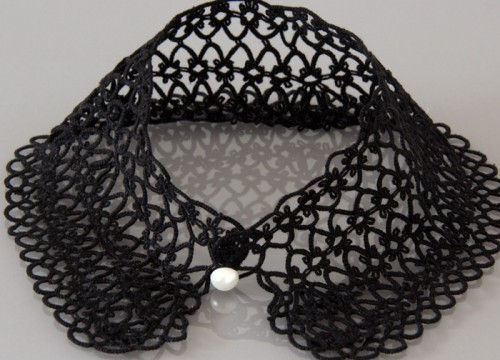
| You have no items in your shopping cart |
Transportation cost: Poland: 14 - 16 zł, Worldwide: from 22 zł

| You have no items in your shopping cart |
Fancy lace and silk collar, manufactured by masters of Polish handicraft in cooperation with the fashion designer.
The collar is filled with open-work meshes. Pattern becomes thicker near the edge – an element recalling leaves or flower petals emerges here. The edge is finished with “wave” characteristic for Bobowa – famous region in Poland for lace manufacturing. It is well worth to pay special attention to the aesthetic accomplishment of the collar and its decorative, adjustable buckle. This type of lace – so called lace-brick, poses true rarity in the field of handicraft. It is ranked among the so called true laces, that is among laces which are impossible to unstitch with one thread and which manufacturing requires the most complex lace workshop. That is why it is highly valued and sought-after. Owing to application of linen thread, the collar is naturally rigid. It will be an elegant, timeless and fashionable accessory to various garments.
See the styling ideas prepared by the fashion designer.
When defining the word lace, we can say that it is a construction composed of interwoven thread. However, a considerably more pertinent name appears to be the poetic term for one of the lace making techniques – ‘punto in aria’ – sewing in the air, ‘Lace’ is an invention of a goddess and a task for a queen’ – that is how lace making was described by Federico de Vinciolo, the XVI century lace maker connected with Henry IInd’s court. And although few people are aware about it, it was Queen Bona who popularized the difficult art of lace making in Poland. Helene Modrzejewska – a well known Polish actress made a contribution to the lace renaissance in Poland. She was a mainspring of creating the National Lace Making School in Zakopane in 1883. Soon – a similar school was founded in Bobowa in 1890. Those schools do not exist any more. However, the traditions of the bobbin lace making are still cultivated in Bobowa – and it is regarded as one of the most important lace making centres in Poland. Another essential centre is Koniakow.
Ms Maria is a well-known lace-maker in Bobowa and a laureate of numerous competitions – among others - she achieved a top place in a bobbin lace competition in Bobowa. She has been attached to land since birth and the characteristic regional bobbin lace. She has learnt the secrets of lace-making thanks to her mother and neighbours. In her art she reaches out to the old, traditional patterns that are inspired by ancient traditional patterns, however, she willingly creates her own ones, inspired by former knots and motifs. Apart from old table clothes, Ms Maria is capable of ‘working magic’ with Christmas or other holiday ornaments, jewellery or images of saints.
She often uses decorative, shiny threads and beads, thus real beauties are created – angels, hearts, stars or little animals. Her makes have reached different corners of the world including the USA, Mexico, France, England, Holland, Italy and Slovakia. Ms Maria co-operates with lace-making ladies nationwide and worldwide. She shares her knowledge with children and adults alike during her workshops and festivals. She has passed her passion onto her daughter, too.
No customer reviews for the moment.















